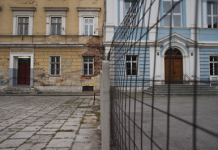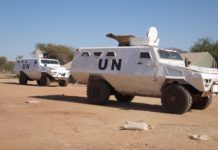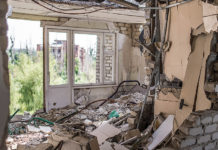In the last two decades, the Arab-Israeli conflict has been considered a “low intensity” conflict, based on a typology which simply takes into account the number of casualties. This typology is misleading, since despite relatively low numbers of casualties, on other counts the conflict may be seen to be in the process of intensification. In particular, a key area that has been gaining relevance is related to space and land: dispossession, occupation and destruction of Palestinian living space and what I call spacio-cide.
Since the Zionist myth of a land without people for a people without land, the policy of successive Israeli governments has been to appropriate land while ignoring the people on it. The founding myth has been perpetuated, and, in its more modern form, can be seen in the policy of acquiring the most land with the least people. The resulting institutionalized invisibility of the Palestinian people both feeds and is being fed by Israel’s everyday settler-colonial practices.
For example, parts of the Israeli West Bank wall are being constructed specifically to remove the visual presence of Palestinian villages. Moreover, this enforced invisibility sustains an Israeli system neither interested in killing nor in assimilating the Palestinians. Asking the Palestinians of Israel to be loyal to the State has never brought with it the prize of equal citizenship; while the Israeli narrative sees Jerusalem as its “eternal unified capital,” it does not try to assimilate the quarter of a million of Palestinians of the city.
In this paper I will argue that, the Israeli colonial project is “spacio-cidal” (as opposed to genocidal) in that it targets land for the purpose of rendering inevitable the « voluntary » transfer of the Palestinian population primarily by targeting the space upon which the Palestinian people live.
This policy involves a mix between three strategies. First, it involves ‘space annihilation’, to paraphrase Kenneth Hewitt (1983), similar to that witnessed in Europe during World War Two (destruction of Dresden, Hiroshima, settlements in north-west France), though differently in the case of Israeli practices this is a major not minor tactic. The second strategy is the ethnic cleansing, to use the words of Ilan Pappé (2006) who demonstrated how ethnic cleansing was not a circumstance of war, but rather a purported goal of combat for early Israeli military units led by David Ben-Gurion.
The third strategy, deployed in the face of resistance to space annihilation and ethnic cleansing, consists of what Oren Yiftachel calls « creeping apartheid. » Creeping apartheid utilizes increasingly impregnable ethnic, geographic, and economic barriers between groups vying for recognition, power, and resources. (2006)
What is the spacio-cide?
Compared to other colonial and ethnic conflicts (Rwanda-Burundi, Serbia-Bosnia, etc.), the 1948 war did not, relatively speaking, produce many casualties. The notion of al-Nakba (the Catastrophe) is based on the loss of land and refugeehood, rather than the loss of life. Even after six years of Intifada, the number of victims is relatively low. During 60 years 89,000 died (72,000 Arabs and 17,000 Israelis) compared to the six weeks of madness in Rwanda in which some 800,000 people were killed or to four years of Bosnian-Serbian (100-200,000 killed).
The Israeli settler-colonial project is not a genocidal project but a “spacio-cidal” one. In every conflict, belligerents define their enemy and shape their mode of action accordingly. In the Palestinian-Israeli conflict, the Israeli target is the place. Spacio-cide does not entail therefore «postmortem city» as Chris Hables Gray described an aerial «damage assessment» map of Tokyo after the US firebombing devastated the city in March, 1945, resulting the killing over 130,000 civilians in a few hours (Graham, 2004). It is rather spectacle of destruction without/with little death.
Different reports produced by the Jerusalem Emergency Committee, a working group set up by Jerusalem-based NGOs after the April 2002 Israeli invasion, showed systematic destruction of public places: all but two Palestinian ministries and 65 NGOs were totally or partially destroyed. Destruction was not the side effect of the war but the main leverage of political pressure. What was striking about this wanton destruction was the vandalism.
To seize documents and computer hard drives from the Ministry of Education can be “understood” within the framework of a military hunt for information that would prove that the Palestinian public educational system “produced incitement and engendered suicide bombers,” but why did soldiers also have to smash the computer screens and tear apart the furniture?
During the war years in the former Yugoslavia, architect and former mayor of Belgrade, Bogdan Bogdanovich (1993) was one of the first to coin the term “urbicide” to describe the destruction of cities in the Balkans. Serbian nationalism romanticized rural villages where a single community spirit predominated. The city, in this context was a symbol of communal and cultural multiplicity, the antithesis of the Serbian ideal. In the Palestinian occupied territories, the entire landscape has been targeted.
The weapons of mass destruction are not so much tanks as bulldozers, which have destroyed streets, houses, cars, and dunam after dunam of olive trees. It is a war in an age of literal agoraphobia, the fear of space, seeking not the division of territory but its abolition. A trail of devastation stretches as far as the eye can see: a jumble of demolished buildings, leveled hillsides and flattened wild and cultivated vegetation. This barrage of concentrated damage has been wrought not only by the bombs and tanks of traditional warfare, but by industrious, vigorous destruction that has toppled properties like a violent tax assessor. So far, these policies have climaxed with the destruction of a third of the Jenin Refugee Camp.
The Israeli project during this Intifada has as its objective to make a kind of “demographic transfer” or what one Israeli minister has called a “voluntary transfer” of the Palestinian population by transforming the Palestinian topos to atopia, turning territory into mere land. It is by the means of spacio-cide that Israel is preparing such a population transfer, and already, since the beginning of the Intifada, around 100,000 Palestinians have left the country, some 3.3 percent of the Palestinian population in West Bank and Gaza.
People have been forced to migrate internally as well. In Hebron, for instance, some 5,000 people (850 families) have left the Old City to neighboring villages because of Jewish settler vigilantism harassment and violence, and Israeli army imposed curfews. House demolitions are another tactic used to induce this transfer. From the beginning of the current Intifada in September 2000 until September 30, 2005, 73,567 housing unit were damaged whose 7,633 were destroyed completely in the West Bank and Gaza. And the numbers just keep rising. This destruction has taken place mainly in Rafah, Jenin, Nablus, Hebron and Jerusalem, and many of the refugees of these demolitions are already refugees from 1948 or 1967.
Transfer is also brought about with the “de-naturalization” of some 200,000 Palestinians who have found themselves trapped between Israel’s West Bank barriers and are now neither in Palestinian nor Israeli space, but are rather de facto stateless and space-less. This “spacio-cide” has been rendered possible by the Israeli division of the Palestinian territory into zones A, B, B-, B+, C, H1 and H2. These areas are fragmented by the bypass routs system, dividing West Bank into 64 small Cantons.
In such a scheme, Palestinian national infrastructure development became almost impossible, due to the fragmentation of space, but also to the fragmentation of the Palestinian political system. The PNA cannot, for example, implement water reservoir projects for a set of villages if the pipeline passes through zone C. Paving of the new road between Bethlehem and Hebron was halted in 1999 because Israel did not grant authorization to pass through zone C. There has been urban development in zones A and B, but these are always surrounded by Israeli zones, curtailing the possibilities for industrial or residential urban expansion.
Furthermore, either unwilling or unable to pressure Israel, the international community’s various agencies have been reluctant to negotiate with the Israeli authority concerning funding projects in Jerusalem or Palestinian localities in zone C.
Justifying the Spacio-cide
As Coward (2007) argue about the urbicide, the lexical kinship with genocide meant that spacio-cide could, by association, draw on a number of assumptions underpinning the former category. Thus the use of the term ‘spacio-cide’ emphasized both the magnitude of the wrecking and destruction, and the deliberate exterminatory logic of the space livability that underpinned the assault on the space, whether it is build/urban area, landscape or land property. Any reading of the Palestinian-Israeli conflict using the genocide as the extent of the colonial violence will be incapable to understand the dynamic of this conflict.
The spacio-cide is a deliberate ideology, albeit with dynamic process, and widespread destruction practices produced by four actors: the military forces, settlers’ land grabbing, urban planners and capitalist real estate speculators. While these actors may seem to be distinct actors, they are often working so closely to reach the specio-cidal strategies.
The example of Jaffa city is a striking example in this regard. In 1948, the political-military Israeli authorities have emptied the majority of the population from the city by expulsion of majority of its population and then expropriate them using the Law of the Absentees’ Property. In 80s, the state sought to develop the Southern Tal Aviv at the expense of Jaffa.
The targeted area is the strategic costal al-Ajami quarter. Contrary to the liberalism where the state had just been an arbitrage force between the different market actors, in the neo-liberalism, the state is involved in the market by establishing alliance with some capitalists. In the case of Jaffa, this alliance was very obvious by impeding the Arab population of reconstruction and refurbishing this quarter.
However Jewish population was afraid to live there, cohabitating with the Palestinian population. As a beginning of the gentrification process, the State intervenes by allowing the construction of a highly securitized and gated community in the heart of al-Ajami. The real estate capitalist has refused to let a Palestinian to buy or to rent there. This was the headspread for other capitalist speculators with the help of the state to buy more land and to “Judaization” of the area. In somehow, since 80s, all that happens without “violence” and without property confiscation but just by the force of the neoliberal system.
This article will focus only on the first three types and not to deal with the fourth type of actors of the spacio-cide, capitalist real estate speculators, as it is less important in the spacio-cide processes in the Palestinian territory. Indeed, while spacio-cide a good term to describe the whole Israeli project from 1948 till today, one should acknowledge that its techniques are different through time and the salient stage is after 1967 when it becomes the main colonial practices in Palestinian territory. While the potentiality of the spacio-cide as practice is always present, in certain moments after 1967 it has become more thinkable, more conscious, and therefore more doable and more extreme than in the past.
In this territory, the spacio-cide has been applied independently of the peace-process to increase the settlement of the Jewish population. Even after the signing of these accords, the number of settlers increased three-fold (from 120,400 to 438,088 ) and the area of the settlements doubled, constituting 129 settlements. Even after the Israeli withdrawal from Gaza Strip, Israel has evacuated 8,500 settlers from Gaza and part of northern West Bank but has embarked on plans to make room for 30,000 new settlers this year alone (2005), primarily in and around occupied East Jerusalem.
Zionist project failed to acquire land especially during British mandate in spite that fact that British administration had helped them. It is very important to note that in spite this strategy, the Zionist movement obtained until 1947 only 7% of total land of Palestine. Two reasons can explain that: awareness of the Arab of the Zionist project and price of the last which become expensive (around $ 1100 for the Acre). In contrast, British colonialism was very much acquiring land, whether by confiscation or by buying it from indigenous people, usually with little money, the Zionist project was so a project of controlling and creating urban space, like the French colonialism.
Bibliography
Bogdanovic, Bogdan (1993) Murder of a City. New York review of Books, XL/10, 27 May.
Coward, Martin (2007) “’Urbicide’ Reconsidered”. Theory & Event. Volume 10, Issue 2. The Johns Hopkins University Press.
Graham, Stephen (2004) “Postmortem City: Towards an Urban Geopolitics” City, vol. 8, no. 2.
Hewitt, Kenneth (1983) «Place annihilation: Area bombing and the fate of urban places», Annals of the Association of American Geographers, vol. 73, no. 2, pp. 257-284.
Pappe, Ilan (2002) “The Post-Territorial Dimensions of a Future Homeland in Israel and Palestine”. Ann Lesch and Ian Lustick (eds.) Exile & Return. Predicaments of Palestinians and Jews. University of Pennsylvania Press.
Pappe, Ilan (2006) The Ethnic Cleansing of Palestine. Oneworld Publication
Yiftachel, Oren (2006) Ethnocracy: land and identity politics in Israel/Palestine. Philadelphia : University of Pennsylvania Press.
Sari Hanafi
Derniers articles parSari Hanafi (voir tous)
- Spacio-cide as a Colonial Politics in Palestinian territory – 30 septembre 2009
- Territoires palestiniens : le « spatio-cide », une politique coloniale – 25 septembre 2009







